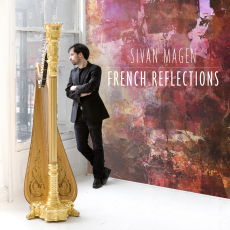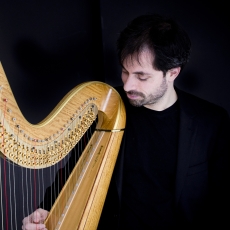Sivan Magen - French Reflections - Audio Video Club of Atlanta
I first reviewed harpist Sivan Magen in “Opus 1,” an imaginative program in which he collaborated with other members of the Israeli Chamber Project. I recall being impressed with his fast pedalling and sure registration changes in addition to his ability as an skilled arranger. Since then, the Jerusalem native has moved to New York City and conducted master classes in his instrument in the U.S., the U.K., Finland,Taiwan, and elsewhere, even as his reputation as a harpist with a demon technique has continued to grow.
The present CD allows Magen lots of opportunity to display his talents in a program that tastefully mixes in arrangements of charming pieces by Debussy and Fauré as a balance to works by lesser-known French composers that are distinguished by their everincreasing technical demands in the interest of virtuosity and expressiveness. Spurred by new advances in harp design, early 20th century French composers occupied themselves with sonority, resonance, imagery, and exotic modes. And as Magen puts it, what instrument was better suited to explore those new realms than the harp?
The bookends of the program are pieces by Fauré: Une châtelaine en sa tour, a forlorn-sounding work based on ever more plaintive harmonies (perhaps a lament for losses suffered in the Great War?) and a rather extroverted Impromptu, Op. 86, written as a concourse piece. One can divine this purpose from its virtuosic use of harmonics, glissandi, cross fingerings and rich arpeggios.
André Caplet, composer-arranger, conductor and close associate of Debussy, is heard from next, in the form of a Divertissement whose two movements, marked à la Francaise and à l’espagnole, are audacious send-ups of national styles that involve such features as jewellike harmonics, scalar motifs taken at dizzy speed, and pedal glissandi. The French piece is more brilliant, the Spanish rather more languid and passionate. Esstal by Philippe Schoeller (b.1957) is an avant-garde work which its composer describes as “visited by archaic accents.” Says Schoeller, “I imagine a harp, peaceful and yet still menacing.” My impression of this austere work marked by widely-spaced notes and occasional knocking on the soundboard of the harp, is somewhat different. Where Schoeller envisions enchantment, my personal response is that it sounds like music to contemplate suicide.
I found Sonatine by Marcel Tournier (1879-1951) a more engaging work. In three movements, titled Allègrement, Calme et expressif, and Fièvreuesement (feverishly) it combines color, discrete sensuality, and, in the finale, bold arpeggio figures that add excitement.
The most familiar pieces on the program are two of Debussy's Estampes (1903): La soiree dans Grenade and Jardins sur la pluie. Both are highly evocative: the warmth of a Spanish night with the strumming of guitars in the former, and the splashing of raindrops on windowpanes and the descending sheets of rainfall that are characteristic of a cloudburst in Normandy. The arrangements, presumably Sivan?s own, make a worthy comparison with Debussy's piano originals.
Tocar by Bruno Mantovani (b.1974), as its name suggests, explores a wide variety of touch-play sensations. To quote the booklet notes, “Mantovani utilizes a breath-taking spectrum of attacks and techniques: furious scalic motives, nail sounds, bisbigliandi, and sudden, shrill fortes which makes [it] a testament to the harp's more virile characteristics.” As Magen presents it, Tocar is actually more euphonious than we might have expected, given the strangeness of many of its sounds. (By the way, bisbigliandi, Italian for “whisperings”, are light, murmuring sounds produced on the harp by a fingered tremolo.)

